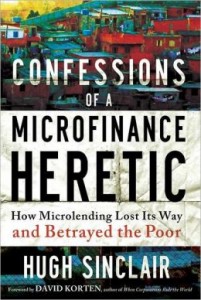
Some microfinance is extremely beneficial to the poor, but it is not the miracle cure that its publicists would have you believe. Microfinance has been hijacked by profiteers, and we need to reclaim it for the poor. The problem is not with a few rogue operators, alas, but with systemic flaws that permeate the sector.” Thus does Hugh Sinclair lay out the thesis he pursues in Confessions of a Microfinance Heretic. The essential truth he reveals is that microcredit doesn’t end poverty.
Microfinance doesn’t end poverty
If you skip over that statement in the opening pages of the book, you could easily conclude that Sinclair can see no good at all in the $70 billion industry that has grown up under the impetus of Muhammad Yunus‘ 2006 Nobel Peace Prize. After all, Sinclair writes — at least twice — that he wouldn’t invest a single dollar in microfinance today. Nonetheless, he insists that the “debate is not whether microfinance works, but how the inherent conflicts of interest can be managed.”
Confessions of a Microfinance Heretic: How Microlending Lost Its Way and Betrayed the Poor by Hugh Sinclair ★★★★★
Systemic flaws in the microfinance industry
The systemic flaws Sinclair perceives are eye-opening:
- A majority of the money loaned to poor people goes not to help them launch or sustain microbusinesses to supplement family income but rather for current consumption, sometimes to buy food during a time when there’s not enough money coming in, sometimes just to buy TV sets.”Estimates for consumption loans range from 50 percent to 90 percent of all microfinance loans,” depending on the study. As Sinclair points out, citing numerous sources, the proportion of entrepreneurs among the poor is no bigger than it is among the rich. It’s naive of us to expect otherwise.
- The interest rates charged for microloans are, far too often, prohibitively high. Muhammad Yunus’ benchmark — 10 to 15 percent above the cost of money — is rarely observed. Though there are indeed many, mostly small, nonprofit MFIs (Microfinance Institutions, generally microloan lenders) that charge no more than 25 or 30 percent, the bigger institutions, and most of the for-profit banks in the industry, typically charge far more. In one notorious case, the effective interest rate runs as high as 195 percent, but there are many other instances in which the rate exceeds 100 percent. It’s no wonder that microfinance doesn’t end poverty.
- The amounts of money loaned by MFIs are far too small to permit businesses to grow to a size where they may employ workers outside the family. In fact, to the extent that businesses remain family-run, they frequently employ even the youngest children, sometimes withdrawn from school to work in the business. However, there’s another side to this question, as Sinclair reveals in an exchange with one businesswoman: “[W]e asked her about her future plans for the business, and whether she thought it could be built up further and be a useful business for her children to take over. ‘You misunderstand me. I don’t do this job because I like it or want to grow it into a big business. I do it so my children will never have to do work like this.'”
- In countries where local laws and a lack of government oversight give free rein to the MFIs, competition run wild among them has sometimes led to credit crises. In India’s Andhra Pradesh state, for example, “There were more microloans than poor people.” And in Nicaragua “total lending by MFIs was estimated at $420 million in 2008, in a country of about 5.5 million, not all of whom were poor (and MFIs generally don’t lend to children).” Microloan customers frequently borrowed from several of the country’s 19 MFIs — the nationwide average was four — often to be able to pay back loans to other MFIs. “One particularly ambitious client in Jalapa had managed to rack up $600,000 in micro-loans.” As Sinclair disclosed in a talk he gave in Berkeley a few weeks ago, Nicaragua was only the first of several countries where the microcredit bubble is likely to burst. Stay tuned, he said.
- The profit motive appears to have become the central preoccupation of the microfinance funds, which function like private equity funds, gathering together investment dollars and placing them in selected MFIs. Even some of the biggest and most prestigious of these funds — including the Grameen Foundation (USA), Calvert Foundation, Kiva.org, and BlueOrchard (the world’s largest) — have been tainted by longstanding investments in some of the most egregiously exploitive MFIs, brushing aside mountains of evidence that their investments were helping victimize poor people in Nigeria, Mexico, and other countries.
No documented evidence that microfinance works to lessen poverty
Despite all this, there is NO documented evidence that microfinance has achieved any reduction at all in the level of poverty. As a 2007 article in the Harvard Business Review stated, “In 1991, for example, Bangladesh ranked 136th on the UN Development Programme’s Human Development Index (a measure of societal well-being); 15 years later it ranked 137th.” And Sinclair writes, “In 2001, Nicaragua was the 106th poorest country in the world . . . Microfinance was almost unheard of in Nicaragua at this point, and there were no large microfinance funds throwing money around. By 2009, when the full Nicaraguan microfinance meltdown occurred, Nicaragua had slipped to 124th place.”
Hugh Sinclair is no cranky, slapdash journalist taking on a controversial subject for the sake of selling books. He is a ten-year veteran of the microfinance industry and has been involved as either an employee or a consultant by dozens of MFIs around the world and in several microfinance funds. He clearly knows whereof he writes, his citation of sources is extensive, and his publisher, Berrett-Koehler, is a highly respected source of books on business and current affairs. With a source like this claiming that microcredit doesn’t end poverty, it’s worth reconsidering what you’ve thought about the topic in the past.
Confessions of a Microfinance Heretic is an important book that should be must reading for anyone involved in international development.
For further reading
This is one of the books I’ve included in my post, Gaining a global perspective on the world around us.
For books on closely related topics, see:
- Narrowing global inequities: a reading list
- Third World poverty and economic development: a reading list
- The top 10 books on the economics of poverty
- A resource list on social enterprise
And you can always find my most popular reviews, and the most recent ones, plus a guide to this whole site, on the Home Page.


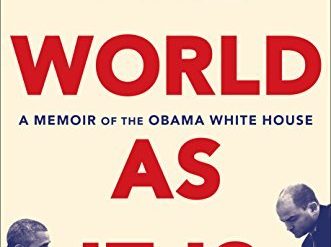
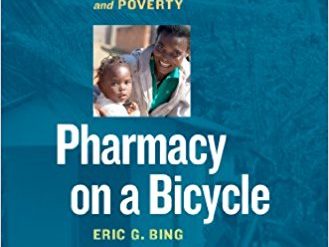
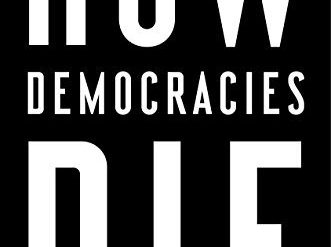
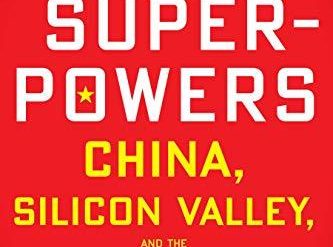






















Thank you for posting this. It’s definitely very troubling when stories come out about exploitative groups who pose as world changers, yet it turns out they’re hiding behind a philanthropic cause to fund their own luxurious lifestyles; tainting the work of those who genuinely do want to find real solutions and help people.